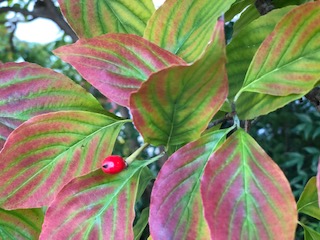Chesapeake Native Plants: Early, Mid & Late Fall Color
- Nuts for Natives
- Oct 27, 2021
- 4 min read
Maximizing fall foliage hues.

A few weeks back, I tuned into a webinar hosted by the Lewis Ginter Botanical Garden in Richmond. Speaker and native garden designer Kim Eierman mentioned something in passing I never considered: thinking about fall color in waves. I often see spring and summer blooming plants described as early, mid or late season bloomers but had never thought about choosing plants for fall color at different times. It makes complete sense of course.
This fall, I am noting, or rather taking photos of, perennials, shrubs and trees when leaves begin to turn. I'm hoping to figure out where there are gaps in fall color. Of course, this will vary for each of our gardens and from year to year depending on our rainfall, temperatures and other weather, soil and site conditions.
One of the truly great benefits of native plants in the mid-Atlantic is their stellar blaze of colors in fall. Here are some easy to grownatives that, generally, bloom in early or later fall and are available now at nurseries. As they say, your results may vary!
Early fall color (October or so)
Dogwood
The dogwood tree (Cornus Florida) is a four season addition for your garden if there ever was one. Leaves turn to reds and oranges early on. Along with the red fruits, dogwoods stand out as much in fall as in spring when those iconic white flowers grace the tree branches.
Staghorn sumac
Staghorn sumac (Rhus typhinia) is known for its fiery early fall color. These large, suckering shrubs have brilliant red and orange leaves in the fall and produce distinctive red clusters of berries. These can be pruned into small trees. There are also smaller cultivars commonly available. They grow well in dry soils in sun to part shade.
Smooth Witherod
Smooth witherod, sometimes called possumhaw viburnum (Viburnum nudum), is another native shrub to change color early. The changing leaf colors follow berries which typically ripen in August. The range of leaf color is deep and varied including shades of deep reds and maroons. This large shrub grows in average to wet soils in full sun to part shade.
Serviceberry
Serviceberry (Amelanchier canadensis), leaps out of the landscape in fall with orange yellow leaves. This tree reaches 15 to 30' tall. For smaller gardens, there are smaller cultivars that grow as multi-stemmed shrubs or small trees such as Autumn Brilliance serviceberry (Amelanchier x grandiflora) and the even smaller coastal serviceberry (Amelanchier obovalus).
Later fall color (Early November or so)
Bluestar
Threadleaf blue star (Amsonia hubrichtii) is a perennial to plant solely for its fall color though it has strong green foliage all summer. In late fall, leaves turn lemon yellow and then gold. It really is something to behold, particularly when planted in front of evergreens. The time to plant blue star is sooner rather than later as it is one of those perennials that takes a couple of years to get established and thick enough to get the standout fall color.
The blue star above is commonly available at garden centers and is native to the south central US. The blue star native to the Chesapeake is Eastern blue star (Amsonia tabernaemontana) and is more commonly found at native nurseries. It has wider leaves but the same great color.
Oakleaf hydrangea
Oakleaf hydrangea (Hydrangea quercifolia), native to the southeastern US, is a large shrub with four seasons of interest. Of those four seasons, fall is a standout. Oakleaf fall color changes year by year and can range from purply maroons to deep red and rust. Sometimes, all of this color range occurs on one branch. The large leaves and rich colors make an impact in your garden. These grow in part shade to sun up to 12' tall. There are smaller cultivars for smaller gardens. Please note there are a couple of cultivars like "snowflake" that have double flowers. Cultivars with double flowers are not as beneficial to pollinators.
Red Chokeberry

Red Chokeberry (Aronia arbutifolia) is an easy to grow shrub with bright red foliage in fall. It makes a great native substitute for invasive burning bush for red fall color. This shrub grows 5 to 10 feet tall in sun to part shade and in a range of soils.
Spicebush

Spicebush (Lindera benzoin) is a shade loving shrub that turns lemony yellow in fall. In shade, that yellow just pops. Mt. Cuba aptly describes this as an "irregular shaped shrub." While the form is not perfect, between the fall color and its very early yellow blooms in spring, a boon for pollinators, it's a good pant to have in your garden. Spicebush can also grow in part shade or sunnier spots but the more sun it gets, the more moisture it must have.
If you are just beginning to think about fall color or just starting to add natives, these are all easy to grow and, on top of their fabulous fall hues, have multiple seasons of interest.
These plants each have distinctive fall color which is a big selling point so they are in stock at garden centers and native nurseries now. Fall is a good time to plant as perennials, shrubs and trees aren't putting on new growth due to shorter days. Instead, they can put their energy into developing roots preparing them for a stronger start next growing season.
Whether you are beginning to add natives or fine tuning your color palette, a great start is always a good thing. Thanks for gardening for the Chesapeake!

















































Comments